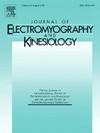用动态关节位置再现任务评估本体感觉敏锐度的见解。
IF 2.3
4区 医学
Q3 NEUROSCIENCES
引用次数: 0
摘要
本研究采用传统的关节位置再现(JPR)任务和改进的动态JPR任务(D-JPR),在同心圆和偏心肌肉收缩时考察本体感觉敏锐度。17名参与者被招募,并在运动的初始(INI),中间(INT)和最终(FIN)阶段,在同心或偏心阶段接受指示位置线索的触觉刺激。运动后,他们复制了他们接受刺激的位置。分析了角误差(AE)和运动速度。AE在D-JPR任务组高于JPR任务组,同心收缩组高于偏心收缩组。在D-JPR任务中,同心收缩时,AE在FIN期比INI期和INT期低,在INT期比INI期低,而在偏心收缩时,AE在FIN期比INI期低。在两种类型的收缩中,均发现刺激传递时的运动速度与AE之间存在显著相关性。本体感觉灵敏度受任务类型、肌肉收缩、运动阶段和运动速度的影响,强调需要考虑这些因素来准确和生态地评估本体感觉。本文章由计算机程序翻译,如有差异,请以英文原文为准。
Insights into proprioceptive acuity assessed with a dynamic joint position reproduction task
This study investigated proprioceptive acuity using the conventional joint position reproduction (JPR) task and a modified version, the Dynamic JPR task (D-JPR), during Concentric and Eccentric muscle contractions. Seventeen participants were recruited and received a tactile stimulus indicating the position cue at Initial (INI), Intermediate (INT), and Final (FIN) phases of movements, during either the concentric or eccentric phases. After the movement, they replicated the position where they received the stimulus. Angular error (AE) and movement velocity were analysed. AE was higher in the D-JPR than in JPR Task, and in Concentric than Eccentric contractions. Within the D-JPR Task, during Concentric contractions, AE was lower at FIN phase compared to INI and INT phases, and at INT phase compared to INI phase, whereas in Eccentric contraction AE was lower in FIN compared to INI phase. Significant correlations between movement velocity at the time of stimulus delivery and AE were found in both types of contractions. Proprioceptive acuity was affected by task type, muscle contraction, movement phase, and movement velocity, highlighting the need to consider these factors for accurate and ecological assessments of proprioception.
求助全文
通过发布文献求助,成功后即可免费获取论文全文。
去求助
来源期刊
CiteScore
4.70
自引率
8.00%
发文量
70
审稿时长
74 days
期刊介绍:
Journal of Electromyography & Kinesiology is the primary source for outstanding original articles on the study of human movement from muscle contraction via its motor units and sensory system to integrated motion through mechanical and electrical detection techniques.
As the official publication of the International Society of Electrophysiology and Kinesiology, the journal is dedicated to publishing the best work in all areas of electromyography and kinesiology, including: control of movement, muscle fatigue, muscle and nerve properties, joint biomechanics and electrical stimulation. Applications in rehabilitation, sports & exercise, motion analysis, ergonomics, alternative & complimentary medicine, measures of human performance and technical articles on electromyographic signal processing are welcome.

 求助内容:
求助内容: 应助结果提醒方式:
应助结果提醒方式:


